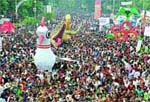Ushering in 1418
Pahela Baishakh Celebration in Dhaka
 The nation welcomed ‘Pahela Baishakh’, the first day of the Bangla year 1418, on Thrusday amidst vibrant pageantry, leaving behind the gloom of the past and pledging to uphold the nation’s opulent cultural heritage.
The nation welcomed ‘Pahela Baishakh’, the first day of the Bangla year 1418, on Thrusday amidst vibrant pageantry, leaving behind the gloom of the past and pledging to uphold the nation’s opulent cultural heritage.
Tens of thousands of people from all walks of life, in traditional clothes, poured into the streets, parks and open spaces across the capital and elsewhere in the country from early morning to welcome the Bangla New Year.
The tradition of celebrating the Bangla New Year — in relation to closing of the annual tax collection — started in the Mughal era. Traders and shopkeepers open ‘haal khata’ (new account books) on this day and offer sweets to clients.
In the course of time, it evolved into a day of celebration and an integral part of the Bengali culture, now considered the biggest secular festival as people irrespective of religion and class commemorate the day.
Chhayanaut, one of the leading cultural organisations of the country, has been holding their ‘barsho boron’ (New Year celebration) since 1967. On April 14, the New Year celebration at Ramna Botomul began with an instrumental recital on violin by Sheuli Bhattacharya. Sheuli played Raga Ramkeli. The melody stirred the senses as the sun slowly emerged and gleamed behind soft clouds.
Teachers, alumni and students of Chhayanaut presented solo, duet and group renditions and recitations at the event. Aside from renditions of morning raga-based songs of ‘Pancho-kobi’ (Rabindranath Tagore, Kazi Nazrul Islam, DL Roy, Atul Prasad and Rajanikant), the artistes also rendered several folk numbers on the occasion.
Secretary General of Chhayanaut, Khairul Anam Shakil, performed “Aaji Gao Mohageet”. Noted singers Mita Haque, Chandana Majumdar and Bizon Chandra Mistry rendered “Ondhojon-e Deho Aalo”, “Ke Banailo Emon Rong Mohol Khana” and “Oi Moha Sindhur Opar Thekey” respectively. A duet number, “Aaji Nutan-o Raton-e Bhushon-o Joton-e”, by Rezaul Karim and Nabanita Chakrabarti followed. “Probhat-o Beena Tabo Bajey”, “Trishit-o Akash Kanpey Re”, “Bhorer Hawaye” and more were the choruses performed by artistes.
Veteran singer Sushoma Das performed a Radharaman number while Elora Ahmed Shukla, Laisa Ahmed Lisa, Nasima Shaheen, Azizur Rahman Tuhin, Sejuti Barua and others also sang at the programme.
In her speech, President of Chhayanaut, Dr. Sanjida Khatun emphasised on fortifying our identity through ceaseless cultural practice and passion.
BTV, BTV World and Bangladesh Betar aired Chhayanaut’s ‘barsho boron’ programme live. This year Chhayanaut also celebrated its golden jubilee.
A festive spirit took over the capital and other parts of the country. Women in white saris with red borders and men in panjabi — decorated with Baishakhi motifs — ushered in the New Year.
Many had ‘panta bhat’ with fried hilsa, daal, green chilli and onion at home, restaurants and fairs. Youngsters had their cheeks painted with folk-themed emblems that added further colours to the celebration.
They thronged the main venue in Ramna. The festivities stretched over to Suhrawardy Udyan, Dhaka University and Dhanmondi Lake areas, bringing the city traffic system to a standstill. Many foreigners clad in traditional Bengali clothes were also seen in and around the venues of celebration.
The crowd turned into a human sea in the afternoon when the temperature came down slightly.
Another major attraction was the decorated procession called ‘Mongol Shobhajatra’, brought out by the students and teachers of Faculty of Fine Arts, Dhaka University. Dhaka University Vice Chancellor Professor AAMS Arefin Siddique with DU teachers and cultural personalities led the procession.
The ‘Shobhajatra’, featuring the giant replica of a crocodile (40 feet long) with three human figures riding on it, trying to kill it, symbolised wiping out the war criminals forever from Bangladesh. Replicas of two tigers also signified the embolden spirit of the nation. Thousands of people joined the procession, dancing along to the beats of dhol and other musical instruments.
There were scores of cultural shows arranged by different organisations, keeping the university area alive with heavy rush of people. It was a day of pure, unadulterated fun and merriment.
Courtesy of The Daily Star




















